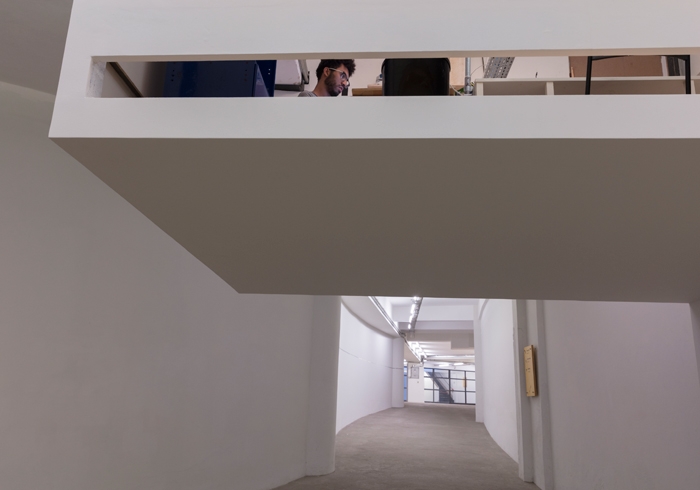Pivô is housed between the ground-floor shops of the Oscar Niemeyer-designed Copan building and the apartments above. Climbing the spiral staircase, one is forced to stoop beneath a low ceiling. While its perfect finish suggests a permanent fixture, it is in fact a minimalist intervention by Laura Lima, one of three artists showing work here, who by adjusting the ceiling’s height reinforces the already peculiar sense of space in this curvilinear venue.
Ana Linnemann’s intervention The invisibles (number 12) (2017) is also site-specific and easily missed. At regular intervals, electric sockets, installed, as one would expect, a few centimetres above the floor, rotate through 360 degrees. It’s an entertaining, if easy, gimmick. Her installation The studio’s table (2018) is cleverer and plays with the function of the building as a residency space. In a constellation of plywood planks and hinges, sometimes supported by books, she presents various elements, occasionally mechanised, that refer to her artmaking process: a pencil and paintbrush are attached to a motor, automatically drawing a circle or twisting around in the air; a teacup is sliced in two – one half red, the other blue. In Incapacitated Room (2018), Lima also turns her attention to the processes behind exhibition-making. She has constructed an elevated room used as an extended office by gallery staff, whose feet are revealed by a small horizontal gap. It’s a playful way of showing the work that normally happens beyond the view of visitors.
Veteran Anna Maria Maiolino presents installations and sound pieces, but the majority of her works shown here are videos with a strong DIY-aesthetic dealing with daily life. Earlier videos have a more explicitly political dimension, and serve as a commentary on Brazil’s military dictatorship (1964–85). In-Out (Anthropophagy) (1973–74) shows a closeup of a man’s and woman’s mouths covered in tape, expressing the impossibility of free speech under censorship. The 16mm film A Day (1976–2016), meanwhile, edits together footage shot during a day out in Rio de Janeiro, alternating images of monkeys with soldiers parading, a satirical juxtaposition that speaks for itself.
By adding the Portuguese translation of T.S. Eliot’s ‘The Hollow Men’ (1925), which is printed on vinyl and stretched out on one of the gallery’s tilting walls, Maiolino not only emphasises the architecture, but uses a century-old poem – which famously ends, ‘This is the way the world ends/Not with a bang but a whimper’ – to evoke powerlessness and gloom, a pessimism that chimes with Brazil’s political climate today. Switching between the political and the personal, the outside world and the studio practice, the presented works share a poetic lightness, united in a difficult venue that is – both spatially and conceptually – used in an intelligent way.
Imannam at Pivô, São Paulo, 8 April – 2 June 2018
From the Summer 2018 issue of ArtReview
